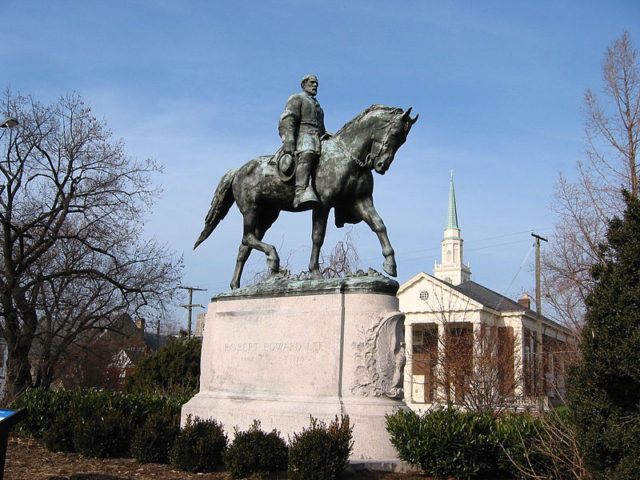
The General Lee statue at the heart of the Charlottesville riots. | Wikimedia Commons
At Hillsdale, the beginning of each semester is typically characterized by calculating the minimum amount of sleep required to function, stressing over the looming workload ahead, and raving over the prospect of reading Dante or Virgil with their favorite professors. But not for students at the University of North Carolina, who, on Aug. 20, seized their last night of freedom to help topple Silent Sam, a confederate statue erected on UNC’s Chapel Hill campus.
The toppling of Silent Sam is not an isolated event — it’s part of a national trend, wherein states and protestors alike have dismantled Confederate symbols throughout the U.S. The logic behind this celebrated annihilation of history is that, by destroying Confederate monuments, we can somehow rewrite history, effectively “purging” America of the stain of slavery and racism that has darkened the pages of history textbooks.
If only all problems could be solved so easily. Then, perhaps, the West could recompense for her anti-Islamic sins during the Crusades by burning all European Cathedrals — or America could erase the memory of Japanese Internment Camps by toppling WWII memorials.
The Taliban, in fact, used a similar justification to destroy the tombs of Biblical prophets.
But these solutions are clearly absurd because history cannot be re-written. It’s fact. Subject to interpretation? Certainly. But it’s fact nonetheless. And it is for this reason that destruction of confederate monuments are futile. Regardless of our own personal sympathies, the Confederacy, the Civil War, and slavery are just as much a part of our cultural heritage as the American Revolution, the good as well as the bad, and these are facts we must confront.
This requires redefining what a monument is. Some argue the only purpose of a monument is to commemorate the dead. But in my view, monuments have manifold purposes, from highlighting the nauseating evils humans are capable of, to sparking a conversation about important political events. Nazi concentration camps do not still stand in Germany because Germans want to promote Nazi virtues. They stand as reminders of the evils that occured because of Nazi ideas.
The most common objections to the preservation of Confederate monuments is that the alleged “purpose” of many of these monuments was to promote white supremacy. But by that logic, perhaps we should seriously reconsider the Lincoln Memorial, since it was erected, not to celebrate the eradication of slavery (something Lincoln himself never fully achieved), but to promote nationalism.
And the notion that Confederate Monuments celebrate white supremacy hardly aligns with modern day sentiments. Having lived in Georgia for 18 years, neither I nor anyone I know — whether they be black or white — has ever considered confederate monuments to promote white supremacy. Rather, these monuments are part of a cultural heritage honoring ancestors who died for a cause they believed was right. And while we may not agree with their decision — I readily admit that southern states were wrong to secede — this only adds to the gravity and importance of preserving these monuments: so that we do not make a similar mistake.
Perhaps the best place for Confederate monuments is not in the middle of the public square; perhaps they ought to be placed inside the Met or a newly-constructed American equivalent to Momento Park (a Hungarian park containing statues of Communist leaders). But in any case, Confederate statues certainly do not belong inside a dumpster outside the UNC campus while Americans applaud themselves for somehow “paying the debt” for their ancestral sins.
Yes, America — and particularly the South — has had dark moments in its past, but to destroy the very icons of that history is nonsensical; it is as if you decided that your house was so messy that the only way in which to clean it was by burning it. You don’t clean your house by burning it down — you get on your knees and start scrubbing. Likewise, America cannot remedy the evils of the past by attempt to destroy the history it doesn’t like; we can only work through issues of slavery and racism by confronting them and asking those hard, uncomfortable conversations that Hillsdale lauds. In this way, Confederate monuments are doing exactly what they ought.
Written by Julia Powell for The Hillsdale Collegian ~ September 20, 2018
 FAIR USE NOTICE: This site contains copyrighted material the use of which has not always been specifically authorized by the copyright owner. We are making such material available in our efforts to advance understanding of environmental, political, human rights, economic, democracy, scientific, and social justice issues, etc. We believe this constitutes a ‘fair use’ of any such copyrighted material as provided for in section 107 of the US Copyright Law. In accordance with Title 17 U. S. C. Section 107, the material on this site is distributed without profit to those who have expressed a prior interest in receiving the included information for research and educational purposes. For more information go to: http://www.law.cornell.edu/uscode/17/107.shtml
FAIR USE NOTICE: This site contains copyrighted material the use of which has not always been specifically authorized by the copyright owner. We are making such material available in our efforts to advance understanding of environmental, political, human rights, economic, democracy, scientific, and social justice issues, etc. We believe this constitutes a ‘fair use’ of any such copyrighted material as provided for in section 107 of the US Copyright Law. In accordance with Title 17 U. S. C. Section 107, the material on this site is distributed without profit to those who have expressed a prior interest in receiving the included information for research and educational purposes. For more information go to: http://www.law.cornell.edu/uscode/17/107.shtml
